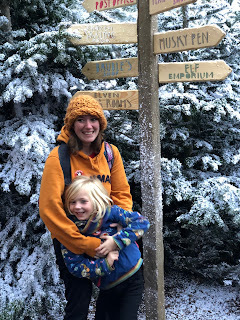When I was approached by the lovely Sarah at Slumber-Roo and asked if I fancied reviewing some of their baby carriers - well - you can imagine my immediate excitement!
Sarah visited the office with three gorgeous slings to choose from and my decision was pretty easy when I saw the beautiful Neko - I couldn’t wait to pop it on and take it for a swing.
So what did we love about it?
Aesthetically, it's 10/10. This particular sling is called 'Rainbow Royale Jasmine' and is a stunning mixture of woven pinks, yellow and oranges, made with 100% bio-cotton and duraflex belts.
It's also really comfy to wear! Whether that's simply because it's new and hasn't been worn in yet, or whether it's slightly more structured than the Tula carrier, I find I get far less aching in my shoulders and back wearing the Neko.
It also has a fully adjustable panel, width & height, suitable from newborn (3.5kg/8lbs) up to approximately 2 - 3 years and a maximum weight capacity of 15kg/33lbs, so is going to really give you great value for money.
It has a very generously sized detachable sleep hood, and the best part is that it's SUPER EASY to attach! Just slide the elastic under the clips and viola...we have instant head support and darkness for those quieter moments that are often few and far between these days! It also means that when my daughter wakes up at the most ridiculous noise (she'll sleep through me dropping my keys, doors slamming, but the theme tune to Peppa Pig comes on and she's SO AWAKE) I can very quickly detach the top so she doesn't wonder why she's woken up in a tent!
So, the downfalls...
Breastfeeding a baby in a sling has been a godsend for me, so I needed to know that the Neko would provide the ease and comfort that my past slings and carriers have allowed. It's comfy and supportive, but the straps seemed to let it down. In my old sling, I simply reach behind me and loosen the straps with one hand to lower Callie to breastfeeding height. In position, I re-tighten and off she goes. The Neko straps felt like they were backwards, so to reach the clips where you feed the straps through, you almost have to be a contortionist (or have someone with you who knows what they're doing!).
However, after posting my original review, the lovely ladies at Neko got in touch with some helpful tips and advice to make my feeding experience with the carrier a positive one - which I can happily say it now is! Using the images below, and by advising me to move Callie higher (which I thought would have the opposite effect) I have finally cracked being able to feed her easily in the sling.
So overall, a beautiful carrier, and very well-made product and one that I would massively recommend. The storage bag is adorable and really handy, and it comes with a great instruction manual which one day, I'll probably have time to read! I love this carrier and get a lot of compliments about it!
I'm excited to share with you two new reviews in the coming weeks - the Boba X carrier, and the Beco carrier! Keep an eye out over on my instagram page for updates and links to the reviews!
*All opinions are my own and no financial gain was involved. Sling provided for review by Slumber-Roo.






















































